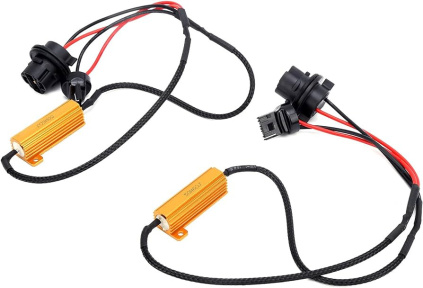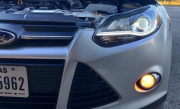
The LED headlights continue to gain popularity because of their practice and reliability. They are relatively easy to convert to and have a lot of benefits to them. More drivers to LED headlights every year because of their outstanding longevity, toughness, superior brightness and versatility.
But despite their simple build and humble appetites, they do need some special parts to function properly. For example, in most vehicles LED headlights must have load resistors in the circuit to give them proper load.
Key Takeaways:
- While LED headlights are efficient, they often need load resistors to function properly, especially in vehicles designed for halogen bulbs.
- Load resistors are essential for balancing out the power discrepancies between LED bulbs and traditional halogen bulbs.
- Choosing the right resistor is crucial. The wrong resistor can lead to LEDs not lighting up, flickering, or even burning out prematurely, and the resistor itself can overheat, posing risks.
They are a crucial part of the headlight system. Such resistors add load to compensate for the notoriously low power draw of the LED bulbs. Without resistors, the computer will believe that the bulb is out and send you a warning message.
There is no difference between a load resistor and a resistor. They are called load resistors because of their main function. They control the necessary load to the circuit of your headlights.
What Is A Load Resistor For LED Headlights?

A load resistor is an essential part of the LED conversion because this small electrical component ensures that the power drop from the LED bulbs is evened out. The resistor provides the appropriate amount of power for the LED headlights while compensating for the low LED draw. LED headlight bulbs are known for their incredible power efficiency, but during conversion, this can pose a problem.
The issue is, if your car was designed for halogen headlights, its computer might interpret the lower power draw of LED headlights as a burnt-out bulb. To circumvent this, you need a resistor in your headlight system. It facilitates the connection between the vehicle and the new LED headlights.
You must establish a new form of communication between the vehicle's computer and your new headlights. Without it, the headlights might malfunction. You could encounter headlight flashing and persistent error codes from the computer.
What Do Load Resistors Do In LED Headlights?
Resistors in LED headlights help to adjust your new less power hungry headlights into the electrical system. If you convert to LED, your vehicle’s computer will get confused because of how little power the LED bulbs draw from the vehicle. This will trigger some compatibility issues with the electrical system.
For example, let's say you have a stock halogen headlight bulb that uses 55 watts. But what if you decide to replace it with an LED headlight bulb, which is more energy-efficient and only uses 20 watts? The answer is simple, you will install a resistor.
The vehicle's electrical system might expect a load of 55 watts from the headlight to return a signal that the headlights operate correctly. When it detects only 20 watts instead of 55watts , it might interpret this as a malfunctioning or a burnt-out bulb.
To address this, you'd use a load resistor that draws an additional 35 watts. When combined, the resistor and the LED bulb together mimic the original 55-watt load, allowing the vehicle's electrical system to function as if the original halogen bulb is still in place.
55 - 20 = 35 watts to add using a load resistor for LEDs.
How Do You Calculate Load of a Resistor for LED Headlights?

Fortunately, calculating the correct load is not complicated at all. You should recall a few things from your school days. Mainly, your physics lessons and the Ohm's Law.
Another thing you need to know if the exact specifications of your stock headlights. For example, let's say the original halogen bulb is 55 watts and operates at 12 volts.
Next, we need the same information about our replacement headlight bulbs. Let’s say, the LED replacement is 20 watts and has the same voltage.
To Calculate the Desired Current Draw
Using Ohm's law, and given the voltage of the resistor required to make up the difference is
V=12×(35/55)=7.6V (proportional to the wattage difference), we can determine the resistance (R) value:
R= I/V
Where the current I is 20/12 = 1.67(from the LED's 20 watts at 12 volts).
R = 7.6V/1.67A = 4.55Ω
For the power dissipation across the resistor, the power (P) is computed using:
P= I×V
P= 1.67A×7.6V = 12.692W
Thus, the resistor will dissipate a power of approximately 12.692W. It would be wise to select a resistor with a power rating that meets or surpasses this value, like a 15W or 20W resistor, to ensure durability and safety.
How many LED Load Resistors Do I Need?

You will typically need two resistors, one resistor per headlight. The number could vary for some car models. Especially if you want to replace DRL bulbs, low beams or high beams that have a unique wiring.
Most modern vehicles these days have a so-called CanBUS system. This system checks if your headlights function properly. If you're replacing halogen headlights with LEDs, it can disrupt the CanBUS’s normal work. If it keeps getting the unusual signals from the headlights, your vehicle will throw an error code or cause flickering.
A pair of load resistors can prevent such issues. Or fix the flickering problem after you convert to LEDs.
How to Choose A Resistor For LEDs?
You need to choose the appropriate resistor for your LED headlight if you want it to work smoothly. There are only three things to keep in mind while you are at it. The most important factors are: resistance value, power rating and, of course, manufacturer.
Use Ohm's law and your LED's specifications to determine what resistance you need. This will guarantee the LED operates at its intended brightness without getting damaged. Or turns on at all.
Based on the resistance and the current, calculate the power the resistor will dissipate. It's advisable to select a resistor with a power rating slightly higher than the calculated value for added safety and longevity.
Reliable suppliers are a must. Do not go cheap on electrical system, it will not end well.
6-Steps to Install Load Resistor for LED Headlights
There are only six simple steps you need to complete to install resistors for your LED headlights. Do not rush the process and be careful. It is recommended to get professional assistance but you can certainly do it yourself with enough skill and knowledge.
Here is what you should do:
- Start with disconnecting the negative terminal of your car's battery. This prevents electrical shocks and accidental short circuits.
- Find the headlight circuit. It's usually near the headlights or the fuse box. Identify the positive and negative wires. You can reference your owner’s manual or video guides to find it.
- Install the resistor either in line with the positive wire connecting one end to the positive wire and the other to the ground wire. Or in line with the negative wire (connecting one end to the negative wire and the other to the ground).
- After installing the resistor, connect the other wire to the ground using a jumper wire or direct connection.
- Mount the resistor to a metal surface for heat dissipation. Use zip ties or tape to keep it in place.
- Reconnect the battery's negative terminal. Test the headlights. If there are issues, the resistor might need replacement.
Will LED Headlights Work Without Load Resistor?
The only functional reason why you would need resistors is to even out the power flow. But if there is no voltage drop to correct, your LED headlights will work perfectly well without resistors.
So yes, your LED headlights can work without resistors but only under specific circumstances. You would typically need to install resistors to fix compatibility issues between the vehicle’s electrical system and the headlights.
Among the common problems are hyper-flashing, flickering, fast burn-out and error codes. This happens when the LEDs draw much less power than the stock headlights. This overthrows the careful balance in the electrical system resulting in faulty headlights.
Do LED Headlight Resistors Produce Much Heat?
Yes, LED headlight resistors heat up when they work. The primary purpose of these resistors is to dissipate excess energy, compensating for the low power draw of LEDs compared to traditional halogen bulbs. so they do just that transforming it into heat.
That can create an issue of its own. It's importan tto mount these resistors on metal surfaces away from plastic or other sensitive components to avoid potential heat damage or melting.
Can You Use an LED Without a Resistor?

Yes, in some cases you can use LEDs without resistors. But that requires a perfect compatibility with the electrical system.
If the power supply is greater than what LEDs need, you should not switch on the headlights before you install the resistors. The bulbs can get damaged, they can even burn out. But even if no lasting damage is done, the vehicle will keep sending error codes and cause flickering.
What Happens If You Use The Wrong Resistor With An LED?
To ensure the proper function and longevity of the LED, it's crucial to select the correct resistor based on the LED's specifications and the circuit's voltage. If the resistor isn't suited for the power it needs to dissipate, it may overheat, presenting a fire hazard or damaging nearby components.
Using the wrong resistor with an LED can lead to various issues. Too high resistance might cause the LED to be dim, not light up, or flicker, while too low resistance can cause the LED to overheat or burn out quickly, also shortening its lifespan.








